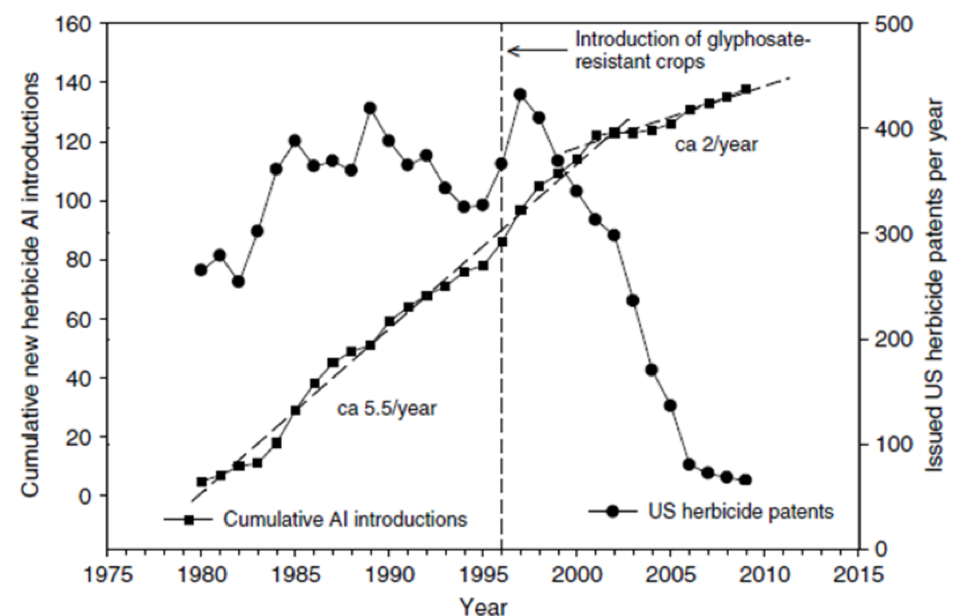Welcome to the Weeders of the West (WoW) Blog. I have been wanting to try my hand at blogging for some time now, but the time investment required has always deterred me. I recently decided to invite my weed science colleagues from the PNW to join me in this effort. To my delight, all accepted my invitation to share their knowledge and experience on weeds and weed management with you. We will be posting a new blog every other week. I hope you enjoy the blog!
I wanted to start the blog with a topic that has consumed a lot of my time in recent years: herbicide resistance. Herbicide resistance has been with us since 1957, shortly after the first synthetic organic herbicide, 2,4-D, became commercially available following World War II. The topic of herbicide resistance did not start to receive much attention until the 1980s. In the 1980s, herbicide resistance to atrazine, a widely used herbicide in corn production, raised some concern. Also in the 1980s, the rapid development of herbicide-resistant Russian thistle and prickly lettuce to Glean (an ALS-inhibiting herbicide; Group 2) in the PNW created a lot of buzz around the topic of herbicide resistance. However, while the topic of herbicide resistance never really disappeared after the 1980s, it never really dominated the agricultural news until recently. Why has herbicide resistance become such a hot topic of late?
Herbicide resistance has been categorized as a “wicked” problem. A wicked problem is defined as a social or cultural problem that is difficult to solve for as many as four reasons: 1) incomplete or contrary knowledge, 2) the number of people and opinions involved, 3) the large economic burden, and/or 4) the interconnected nature of these problems with other problems. So I will not endeavor to lay out all of the reasons for why herbicide resistance has become such a large issue in recent years. Rather, I’m going to join the Internet frenzy and lay the blame on glyphosate. That’s right. Glyphosate is the problem.
Do I have your attention? Actually, glyphosate is not the problem. Glyphosate-resistant soybean and corn are the problems. Roundup Ready soybeans were introduced to the marketplace in 1996 and Round Ready corn and cotton followed in 1997. This technology was rapidly adopted by soybean and corn farmers throughout the US. The technology was simple to deploy, effective, and became relatively cheap once the glyphosate patent expired in 2000 and generic glyphosate products flooded the market.
Corn and soybean farmers greatly reduced their use of other herbicides once they adopted Roundup Ready technology. This had a profound effect on the US agrichemical industry, which relies heavily on profits from corn and soybean production. Roundup Ready crops sucked the profitability out of herbicides for many companies. Many agrichemical companies merged or closed their doors after the introduction of Roundup Ready crops. Those companies that remained greatly reduced investment in new herbicide discovery, shifting discovery resources to fungicides and insecticides. There has not been a new herbicide mechanism of action introduced into the US market since 1990, when the first HPPD-inhibiting herbicide (Group 27) was rolled out for use in corn.
The following figure shows the precipitous decline in US herbicide patents following the introduction of glyphosate-resistant crops. Patents precede the introduction of new active ingredients (AI), which is observed in the figure as a flattening of the curve of the cumulative number of herbicide active ingredients following the drop in US herbicide patents. Prior to the introduction of Roundup Ready crops there were about 5.5 new herbicide active ingredients (not new mechanisms of action) introduced every year. After the introduction of Roundup Ready crops, only about 2.2 new herbicide active ingredients were introduced each year.

The lack of investment in new herbicide discovery is, in my opinion, the major reason that herbicide resistance is such a hot topic of late. In the past, when weed populations developed resistance to a specific herbicide or herbicide mechanism of action, there was always some new herbicide coming along to take its place. Farmers did not worry too much about herbicide resistance because they believed that there would always be something new coming along to solve their problem. However, that is not the world we live in now: the world following Roundup Ready soybeans and corn. We are very unlikely to have a new herbicide, particularly with a new mechanism of action, come along anytime soon to rescue us from our poor stewardship of existing herbicides. This is particularly true for the Pacific Northwest, which is a region of secondary interest to the agrichemical industry. Now that is a wicked problem!